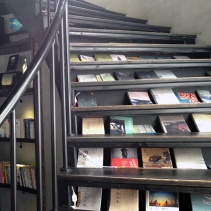Shenzhen is a bookish city. Even a click over to the English language Alibaba site for “Book Printing in Shenzhen” suggests the extent of how many books are printed in the city. We are so awash in books that it is possible to use them instead of wallpaper when decorating. What’s more, many of my favorite cafes are not only decorated with books, but also serve as lending libraries via 青番茄, a Shenzhen based NGO. All you have to do is register online and then you are free to lend and return books at any of their almost 2,000 participating cafes in China.
On Wednesday, I had lunch at the Sophia Cafe (书啡), the name itself casually punning Greek, English, and Chinese. The manager comes from Taiwan and has developed a tasteful (in all possible senses of the word) menu, as well as training staff to be cheerfully attentive in ways that surpass Shenzhen’s already high standards. Books adorn the walls, can be taken down and read, can be borrowed and/ or purchased. This plethora of books created an atmosphere in which it seemed possible to absorb knowledge while sipping coffee or eating an organic salad with extra-virgin olive oil.
Here’s the thing: Sophia’s is located in Dalang, a street office in Longhua New District. At present, Dalang is primally a manufacturing center. The population is about 500,000 migrant workers with only 8,000 locals. Dalang has only three upscale residential areas, all located near the subway line, while the rest of its population lives in quilt of urban villages and industrial parks.
Dalang is home to Fashion Valley. 22 of Shenzhen’s top fashion design firms will move headquarters to Dalang, bringing together all stages of the production chain into one zip code.Sophia’s is part of efforts to upgrade Dalang into an urban environment that will keep talent in place; yes, yes, they may come for the jobs, but the idea is that they will stay for the pleasures of first class consumption and of course, culture. The fact that Dalang now offers great coffee, salads, and books alerts us to how pervasive the cultural restructuring of Shenzhen has been.
Less than half a year ago, the Artron Centre book wall opened to the public in a sophisticated and highly media focused campaign. The wall itself is 164 feet long and 98 feet high (almost two football fields of books, except vertical) and houses over 50,000 art books, in ten languages, from at least 2,000 publishers. Images of the wall appeared throughout the international press, not only showcasing the city’s cultural aspirations, but also the city’s ongoing success in rebranding itself as an international city (and not “just” the world’s factory).

The Artron Art Centre book wall
Shenzhen’s cultural industry is already ten years old and entering its second decade. The cultural industry push has been part of the city’s concerted efforts to re-brand itself both domestically and internationally have worked, and in media both home and abroad the sign “Shenzhen” seems to be consolidating into something about the meaning and possibility of the post Cold War order of things. The Shenzhen Hong Kong Bi-City Biennale of Architecture/ Urbanism, of course, has been the poster child for this transformation.
Seductive and smooth, this rush to the profits of Shenzhen Future has inquiring minds wondering: now that we’re in the lead, where’s the juggernaut headed?







Nice article. Looks lovely in there! Can I get a link or an address to check it out? I’ll get lost if I run a Baidu search for 书啡 😛
I wish the books in all the other cafes I went to in China were real, and not actual Wallpaper (Hollow shells of books put on shelves to create the illusion of engagement with book culture)!